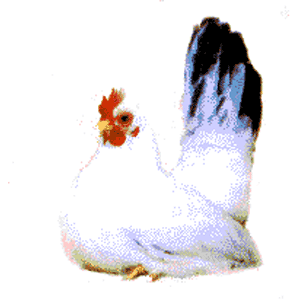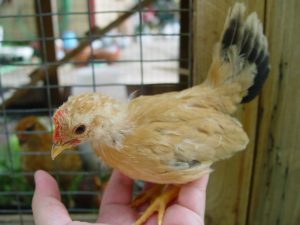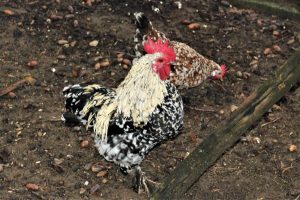
Breed Overview
The Japanese bantam was thought to have been first created in Japan well over 1000 years ago to be bred purely for ornamental purposes. This breed is extremely popular worldwide and is considered one of the top 10 most popular breeds by the ABA. They are often also called “Chabo” which translates to dwarf and is used in regard to chickens and often types of Bonsai trees.
They are believed to have been bred by the aristocratic class in Japan from pre-existing Malaysian breeds. Japanese bantams carry a gene that causes a quarter of all chicks not to hatch as they are heterozygous.
Males weigh just 510-600g (1.1-1.3lbs) and females weigh 400-510g (0.9-1.1lbs).
Eggs
Size
Very small eggs
Color
Tinted color eggs
Production per year
Between 100 to 160 per annum
When do they start laying eggs?
From as early as 16 weeks old

Japanese bantam Characteristics
Temperament / Are they good as pets?
This breed is known to be calm and especially good for those with children. Their coop and run need to be cleaned regularly as their wings touch the ground, therefore, they can easily become dirty.
How do I tame Japanese bantam chickens?
The easiest way to tame a chicken is to pick them up and hold them whilst they are still chicks; this way they become used to human contact from an early age. If you have older chickens or prefer to try another method of taming then you can feed your chickens out of the palm of your hand to get them used to your presence and human interaction.
How many do I need to buy?
Chickens do not do well when they’re lonely and they should always be kept with at least one other friend. However, we recommend a small flock size of 6.
How much space do they need?
These birds are best suited to being kept in confinement as large outdoor spaces are difficult for them to maneuver around in as they have especially short legs and their feathers drag on the floor. They need 11 square feet per bird inside their run and the coop should
Will they mix with my other chickens?
Yes, this breed is calm and friendly and should mix well with any existing chickens that you own.
Appearance
The most notable characteristic of the Japanese bantam is their remarkably short yellow legs clean of feathers; this is caused by a lethal gene that also means that 25{cfcd481556a8b43fba6af451761032bd323e94372a0c1e607} of all Japanese bantam eggs do not hatch. Their tail is upright in the air giving their body a U shaped appearance.
They carry their wings low on their body, meaning the tip of their wings often brushes against the ground. They have a large red serrated comb and a matching red face. There is an array of different colors of plumage, many of which are recognized by poultry associations across the world, the most distinctive part of their plumage is the black-tipped feathers on their tails.

Feeding
What should I feed them?
When your chicks first hatch they should be fed growers mash. This is a refined form of chicken feed that has a higher protein content, especially for your growing chicks. At 6 weeks they can be introduced to chicken pellets, this is a pellet version of chicken feed with a protein content between 15-16{cfcd481556a8b43fba6af451761032bd323e94372a0c1e607}. To help support egg production, at 16 weeks they can be gradually be introduced to layers mash or layers pellets. This form of chicken feed has an average of 16{cfcd481556a8b43fba6af451761032bd323e94372a0c1e607} protein and everything they need nutritionally for egg production.
How much should I feed them?
Bantams need between 2oz (56g) and 3oz (85g) of feed a day each. Start by feeding them the lower amount whilst they are still small and adjust as they grow bigger. You can feed your chickens either at set meal times or you can just leave feed in a feeder for them to help themselves as they please.
What can’t they eat?
The two main things that chickens can’t eat are chocolate and beans; this is because these two foods contain lethal ingredients theobromine and phytohemagglutinin. Anything that has grown mold or is way past its consume by date shouldn’t be given to chickens as bad bacteria found in food that has gone off can make them very unwell.
What do I need to keep chickens?
The first bit of kit that you need to keep chickens is the chicken coop. This needs to have 5 square feet of space per chicken and a little perch for each bird to snooze on throughout the night. Inside the coop, you will need laying boxes that should be filled with wood shavings.
As this breed does well in confinement you will need a run with at least 2 square feet per chicken for them to forage around in the daytime. The run and coop need to be protected from predators so you will need to place a sunken fence around the perimeter of the coop and over the roof as well so that no predators can dig or jump into their enclosure.
Chickens need a water container that can’t be easily knocked over and this should be kept in the shade as they prefer to drink cool water. It is really important that if you don’t have grit naturally occurring in the area your chickens are kept that you buy some for them and keep it readily accessible for them to help themselves to.
